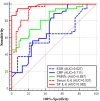Improved diagnosis of chronic hip and knee prosthetic joint infection using combined serum and synovial IL-6 tests
- PMID: 33005398
- PMCID: PMC7502257
- DOI: 10.1302/2046-3758.99.BJR-2020-0095.R1
Improved diagnosis of chronic hip and knee prosthetic joint infection using combined serum and synovial IL-6 tests
Abstract
Aims: This study aimed to explore whether serum combined with synovial interleukin-6 (IL-6) measurement can improve the accuracy of prosthetic joint infection (PJI) diagnosis, and to establish the cut-off values of IL-6 in serum and synovial fluid in detecting chronic PJI.
Methods: Patients scheduled to have a revision surgery for indications of chronic infection of knee and hip arthroplasties or aseptic loosening of an implant were prospectively screened before being enrolled into this study. The Musculoskeletal Infection Society (MSIS) definition of PJI was used for the classification of cases as aseptic or infected. Serum CRP, ESR, IL-6, and percentage of polymorphonuclear neutrophils (PMN%) and IL-6 in synovial fluid were analyzed. Statistical tests were performed to compare these biomarkers in the two groups, and receiver operating characteristic (ROC) curves and area under the curve (AUC) were analyzed for each biomarker.
Results: A total of 93 patients were enrolled. There was no difference in demographic data between both groups. Synovial fluid IL-6, with a threshold of 1,855.36 pg/ml, demonstrated a mean sensitivity of 94.59% (95% confidence interval (CI) 81.8% to 99.3%) and a mean specificity of 92.86% (95% CI 82.7 to 98.0) for detecting chronic PJI. Then 6.7 pg/ml was determined to be the optimal threshold value of serum IL-6 for the diagnosis of chronic PJI, with a mean sensitivity of 97.30% (95% CI 85.8% to 99.9%) and a mean specificity of 76.79% (95% CI 63.6% to 87.0%). The combination of synovial IL-6 and serum IL-6 led to improved accuracy of 96.77% in diagnosing chronic PJI.
Conclusion: The present study identified that a combination of IL-6 in serum and synovial IL-6 has the potential for further improvement of the diagnosis of PJI.Cite this article: Bone Joint Res 2020;9(9):587-592.
Keywords: CRP; Diagnosis; ESR; Interleukin-6; Prosthetic joint infection.
© 2020 Author(s) et al.
Figures
References
-
- Gehrke T, Alijanipour P, Parvizi J. The management of an infected total knee arthroplasty. Bone Joint J. 2015;97-B(10 Suppl A):20–29. - PubMed
-
- Della Valle C, Parvizi J, Bauer TW, et al. . American Academy of orthopaedic surgeons clinical practice guideline on: the diagnosis of periprosthetic joint infections of the hip and knee. J Bone Joint Surg Am. 2011;93-A:1355–1357. - PubMed
-
- Parvizi J, Gehrke T, Chen AF. Proceedings of the International consensus on periprosthetic joint infection. Bone Joint J. 2013;95-B(11):1450–1452. - PubMed
-
- Parvizi J, Tan TL, Goswami K, et al. . The 2018 definition of periprosthetic hip and knee infection: an evidence-based and validated criteria. J Arthroplasty. 2018;33(5):1309–1314. - PubMed
LinkOut - more resources
Full Text Sources
Research Materials
Miscellaneous


